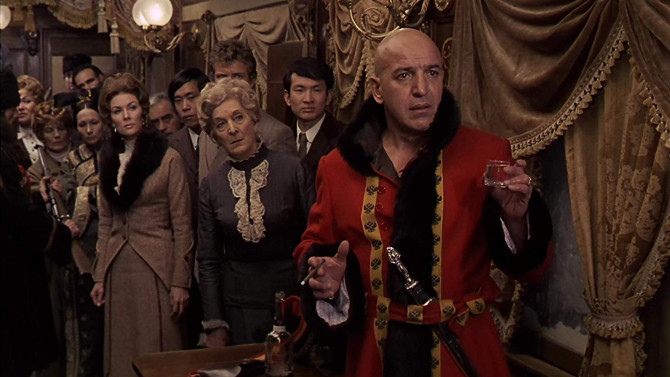Inspector Mirov: The two of you together, that’s fine. . . but what if one of you is the monster?
Dr. Wells: Monster? We’re British, you know.
With a locomotive that is Agatha Christie’s “Murder on the Orient Express”, passenger cars encompassing John W. Campbell’s “Who Goes There?” (the story that inspired both 1951’s The Thing from Another World and 1982’s The Thing), a luggage car that is packed to the brim with historical drama, and it all being coupled together by a combination of gothic and Hammer-style horror, 1972’s Horror Express, directed by Eugenio Martín, is a suspenseful non-stop trip along the Trans-Siberian Railway.
A hodgepodge that seemingly shouldn’t work (the third act even turns into something akin to a zombie movie), this Spanish export somehow melds a variety of genres together to develop an early 20th century set, sci-fi/horror inspired murder mystery with a gothic tinge – I know, quite a mouthful. Following Professor Sir Alexander Saxton (Christopher Lee), a tall mustachioed man with an undeniable presence, the world-renowned anthropologist has discovered a prehistoric half ape/half human hybrid frozen in ice.
Thinking it could be the finding of a lifetime – a gateway to proving so much of our own history, he loads the thawing body onto the Trans-Siberian Express for transport. . . but not before a thief, attempting to pick the lock protecting the historic find, drops dead – his eyes now the colour of a pea soup thick fog. Perhaps even more ominous, a raving monk, Father Pujardov (Alberto de Mendoza), attempts to draw a cross on the crate carrying the creature – yet nothing appears. . . could this simply be a magician’s trick, or is there something supremely evil inside?
With a plethora of passengers on the train, Saxton quickly learns that old acquaintance and competitive scientific equal (a sort of rival), Dr. Wells (Peter Cushing), is also there, accompanied by his trusty assistant, Miss Jones (Alice Reinheart). Also onboard is the aforementioned Father, a spiritual advisor always at the side of the Polish Count (George Rigaud) and Countess (Silvia Tortosa), a thieving spy, Natasha (Helga Liné), as well as the very meddlesome (and overreaching) Inspector Mirov (Julio Peña).
Soon, bodies are piling up. . . each one with the same milky-white eyes – blood seeping from those same peepers, as well as the nose, and mouth. It does not take long for a select few on the train to realize that the creature within the crate has broken loose. . . somehow alive after countless centuries frozen. Further complicating things, the mysterious being seems to be able to take the shape of any other form. . . meaning that it could literally be anyone on the packed train.
Confined by its wonderful locale (the limited budget meant that they only had two cars to film in – once they had finished their shots in the one, they would move to the other – while the crew would rip apart the area they were just in to transform it into another compartment), the claustrophobic train setting making for a tense, danger-round-every-corner feel. Driven by classically trained performances by Lee and Cushing, the pair are at their best – as competitive rivals who slowly warm to each other as the danger grows (a rare film where the two are on the same side). The real life background story is even more touching, for Cushing had just lost his beloved wife. . . arriving onset, he told the filmmakers that he was there out of courtesy to let them know that he was too depressed and heartbroken to do his job. Lee, knowing his friend, invited him to his room for tea – making him laugh for two straight hours. . . the next morning, Cushing arrived ready to work – pure professionalism from the first day to the last. And, if you pay attention, you can see Lee take Cushing under his wing, grabbing the lead in his scenes – and adding a magical warmth between them. Then, at the beginning of the third act, Telly Savalas boards the train as Capt. Kazan – an overly dramatic Cossack who does it his way – to the detriment of everyone else. Giving the film a boost, his performance is the very opposite of Lee and Cushing, an ad-lib master who creates his own lines and adds his own flourishes. . . the only thing I lament is that with Lee and Savalas being two iconic Bond villains, it is a shame Cushing never had the chance (in what undoubtably would have been an engaging performance).
Packed with style, Eugenio Martin utilizes all of the tools at his disposal – at times using a handheld camera to provide a hurried perspective while at others shooting with traditional outlook, also watch for rapid cutting, and an almost psychedelic, violent edge. And, perhaps even more impressive are the very lifelike miniature models built for the exterior shots of the train (which Martin, Lee and Cushing were obsessed with – so much so that they tinkered and played with them when not working). In fact, the models were the exact same used for the 1972 film Pancho Villa – another Martin film starring Telly Savalas.
Matched by an equally mesmeric score (by John Cacavas), the composition features an eerie whistling motif, which runs on and off from start to finish, that is both simple and haunting . . . as if it is calling out from the dark netherworld.
A more than entertaining low budget B movie with an A cast, Horror Express is a taut, tense motion picture that uses its oppressive train setting to bring forth many scares (with a number of dry British laughs along the way). So, don’t just read this review and leave things with a giant cliff hanger, watch this cult classic to experience a monstrously great horror film.




